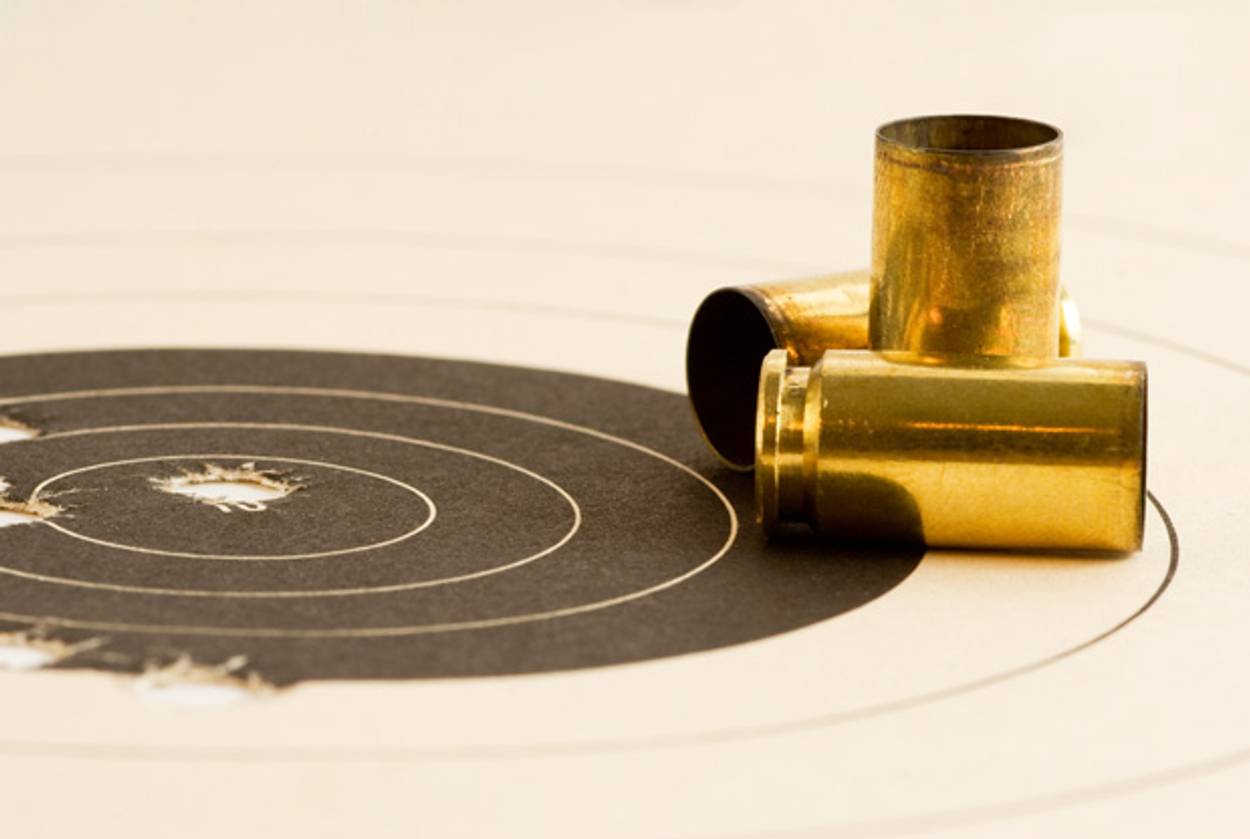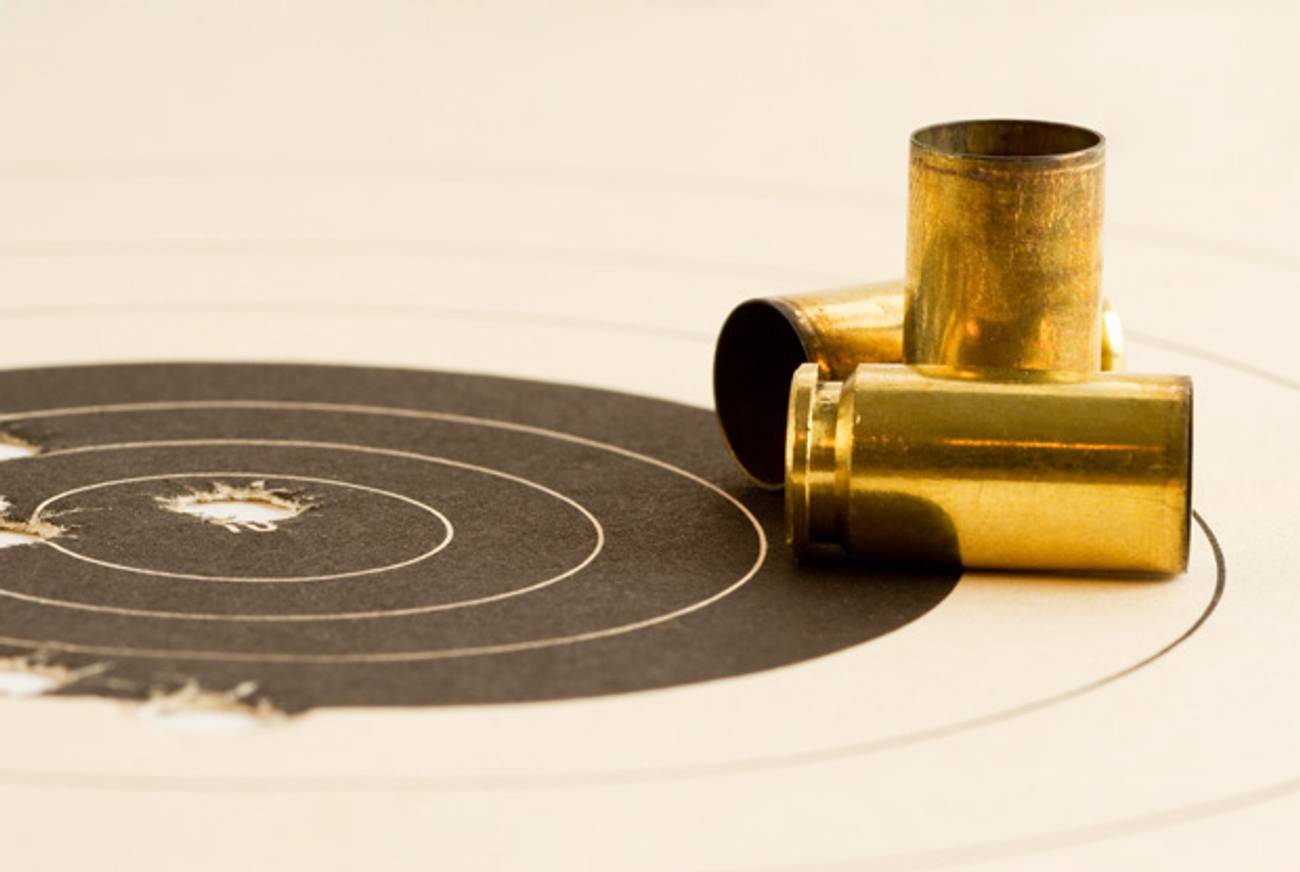The First Time I Shot a Gun
When I decided that my next book would include a gun, I went to a firing range for the first time—and loved it




I’m probably the last person anyone would imagine shopping for a handgun. When I was growing up in the 1960s, guns were about as alien in our household as a crucifix; in fact, they blurred together as symbols of the cruelty inflicted on Jews. Despite the successes of the Israeli army, guns were to me irremediably goyish, and I could never imagine even wanting to touch one, let alone fire it.
That didn’t change as an adult. I still stayed away from guns. Even the amateur sleuth at the center of my series of mystery novels has never used one.
Over the years, each new gun massacre making headlines confirmed my fear of firing. They followed the same pattern we’ve just seen with the Newtown shootings: horrific slaughter, calls for stricter gun laws, NRA craziness, and widespread panic that the government was somehow going to take everyone’s guns away—as if it could.
Despite my personal history and all the headlines, though, I recently walked into a gun shop, and I fired a gun at a firing range for the first time. It was a revelation. I plan on doing it again.
***
I grew up with Holocaust-survivor parents who didn’t want my brother and me to have toy guns, G.I. Joe dolls, or any military board games. Their abhorrence of anything connected to war was absolute, but they grudgingly let us watch Combat on television. When I was older, and facing the possibility of real combat in Vietnam, they were ready to send me to live with a Canadian cousin if I ended up being drafted. Luckily, that never happened.
The news event I remember best from my early childhood was the assassination of John F. Kennedy. When I think of junior high school, it’s the killings of Robert Kennedy and Martin Luther King that stand out as landmarks, the way 9/11 does for many young students in the class I’m currently teaching at Michigan State University. Each news-devouring mass murder in the country following those assassinations fed my abhorrence of guns, reflected in my parents’ own attitudes.
My father’s home was a small town in the mountainous Carpatho-Ukraine region of eastern Czechoslovakia, and he said anti-Semitism was so much a problem there that he always kept a knife in his boot. You might think he would have also had a rifle, given that his father had served in the Austro-Hungarian army during World War I. But the only gun I ever heard my father mention was one that was pointed at him that might have ended his life.
During the Holocaust, my father’s part of Czechoslovakia was seized by Hungary, and the Hungarian army grabbed 50,000 young Jewish men for forced labor. Over 40,000 of them died from malnutrition, exhaustion, frostbite, starvation, cold, war wounds, and cruel treatment by anti-Semitic officers. Out of the 150 young Jewish men sent into slave labor from his small town, fewer than two dozen returned.
My father and other men like him performed heavy labor on roads, building bunkers and digging trenches. Anyone who couldn’t keep up when the weather later turned unbearably hot was shot and left where he lay. The Hungarian officer in charge of their platoon, Imre, took a personal dislike to my father, beating him once so badly that he passed out. Another time, marching with 35 other men, my father was the target of Imre’s grenade, which killed two boys nearby; one had his belly ripped open, and the other’s head was pulverized. When the cart brought my father back to the barracks, he was covered in so much blood, everyone thought he was dead.
Imre’s next attack was indirect. When a German officer appeared and asked for someone who spoke German and Russian, my multilingual father volunteered. He was taken into town as a translator to help the German officer find out about the local partisan network, but he had no idea if any information he heard was valuable or not. Heading back to the labor barracks, they reached a stream, and when my father was halfway across, the German officer said, “Stop—turn around.” He had his machine pistol out. “You know, your officer told me I don’t have to bring you back.” He had his finger on the trigger. Then suddenly he asked my father what his first name was and was shocked by the response: Alexander. “Oh, my God; I don’t believe it,” said the German. “I cannot do this, that’s my name, too.” He gave my father his freedom and returned to his own outfit.
The pistol that almost killed my father came to represent all guns to me—a symbol of the goyim who, as yet another Alexander says in Portnoy’s Complaint, “own the world and know absolutely nothing of human boundaries and limits.” Recent massacres like the ones at Columbine and Virginia Tech and Newtown have only confirmed that dire assessment of non-Jews in my mind; so has the relentless pressure from the NRA to weaken gun-control legislation everywhere it can. There’s an almost religious fervor about guns in this country because they’re so deeply embedded in our founding cultural myth: the Minutemen at Lexington and Concord, and “the shot heard round the world.”
***
Even though seven of my 24 books are mysteries, guns don’t play a major role in them at all, and my protagonist, amateur sleuth Nick Hoffman, has never fired one. But as I planned the book I’m currently writing and laid out the ways in which Nick was to be threatened, the logic of his buying a gun for protection became irrefutable. He needed to use a gun. And if he needed to use one, I needed to use one first. I found a gun shop and a separate gun range close to where I live and called the “shooting center” to sign up for an introductory session.
Neither was what you might picture; the shop was more like a modest neighborhood jewelry store with the guns lovingly displayed in two small rooms. And the very new building 10 minutes’ drive away that houses the gun range is bright, clean, and airy, surrounded by fields. It almost has the feel of a health club or swimming facility. The desk is staffed by friendly college students, and my instructor couldn’t have been clearer and more relaxed as he showed me a 40-minute PowerPoint presentation on gun safety. I went there on a Sunday afternoon, and I was the only “student” in the small lecture room, glad to feel private, taking in everything about safety and the construction of a gun slowly, because I had to keep asking questions. The longer I sat there, the more I felt that the session wasn’t just background for the character in my novel; it was an entrance for me. I loved learning about the construction of a pistol, how it operated, how the components fit together. I hadn’t expected that at all.
Wearing goggles and noise-blocking headphones, I followed him through the two airlock doors into a gun range that looked like a smaller, less-elaborate version of the ones you always see in TV and movie thrillers. There were no separations between the small tables where people were sitting, but again I felt private because there was only one other person firing, and there were half a dozen vacant positions between us. The target wasn’t human-shaped as I’d expected, since the facility’s connected to the local university and the Board of Trustees has forbidden those. It was a sheet of 8 1/2 x 11-inch beige paper with a black circle in its center that was only 2 1/2 inches in diameter. Hanging 4.5 meters away, it looked tiny.
The instructor patiently took me through the Ruger .22 pistol, repeating what we’d discussed before, showing me how to load the clip five bullets at a time, put the magazine in, push down on the slide stop, position the gun in my right hand aiming at the target, curl my right pinky, ring finger, and middle finger around the grip, and secure those with four fingers of my left hand holding the right steady. I had to make sure my index finger was along the barrel and my thumbs parallel to each other and down below the slide, which would pop out when the gun was empty. Last move: clicking down the safety with my right thumb.
I kept waiting for something, anything to feel weird. Instead, I was fascinated, attentive. When I was ready, I took my first shots. There was no recoil with this caliber of gun that I could feel, but the spent cartridges popping out the right side were odd, something my instructor explained would happen but still felt mildly peculiar.
“Have you done this before?” he asked.
I answered, “Never.”
“That’s a very good group.”
He pressed the button to bring the target sheet up to where we sat, and the shots were all inside the black circle, within an inch of each other. I moved the target back half a meter, and half a meter again as the session continued, and wasn’t quite as accurate further away, but still had surprisingly good grouping. Breathing correctly during firing wasn’t difficult for me, but remembering the right order of loading the gun was, which made me grateful for his suggesting only five bullets at a time. Repetition of the steps helped my middle-aged brain absorb the new information and helped my hands learn new skills.
On the way out, another instructor asked me what I’d thought of my session.
“I loved it!”
I left with plenty of data for my book, but also with something totally unexpected: a revelation for myself. I enjoyed target practice. I enjoyed holding a gun. It didn’t seem remotely foreign or bizarre. It felt natural. And I never once thought of my father and the gun pointed at him decades ago.
***
Like this article? Sign up for our Daily Digest to get Tablet Magazine’s new content in your inbox each morning.
Lev Raphael is the author of My Germany and 23 other books in genres from memoir to mystery.
Lev Raphael is a pioneer in writing about the Second Generation and has authored 27 books in genres from memoir to mystery, most recently Department of Death. He coaches and mentors writers at writewithoutborders.com.